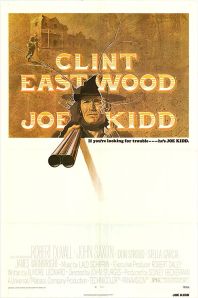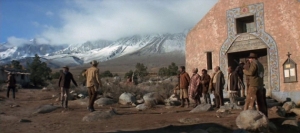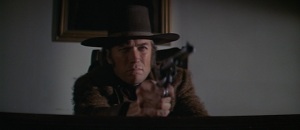At the time Clint Eastwood made “Joe Kidd”, he was one of the hottest movie stars around the world and had already begun putting in place arrangements that would make him a major player in Hollywood for several decades. This was one of a string of Westerns made by Eastwood in the early 1970s but was probably the weakest of the bunch. 
Though based on a screenplay written by the legendary Elmore Leonard, Eastwood has often said that the story didn’t even have an ending when he began filming with director John Sturges (of “The Magnificent Seven” fame). This isn’t A-list Eastwood or Sturges but there could be many worse ways to spend 88 minutes.
We first come across former bounty hunter Joe Kidd (Clint Eastwood) in prison in Sinola, sleeping off a drunken binge before being brought up before a judge. Kidd’s hearing is disrupted by a group of Mexican-Americans led by the revolutionary Luis Chama (John Saxon with a truly horrid Mexican accent), who are protesting the grabbing of their lands by white settlers.
Kidd helps the judge escape while Chama and his group burn the land records and leave town. Soon after, ruthless land owner Frank Harlan (Robert Duvall) rides into Sinola with his gang and asks Kidd, known for his tracking skills, to help him find Chama.
Kidd turns down Harlan and returns to his ranch, only to find his horses have been stolen and one of his Mexican workers tortured by Chama’s men. Kidd rides back into Sinola and throws in his lot with Harlan. 
As Harlan’s posse makes its way through Chama’s territory, Kidd is sickened by the brutality of Harlan’s men, especially Olin Mingo (James Wainwright) and Lamarr Simms (Don Stroud), who kill several Mexicans in cold blood.
Harlan besieges Chama’s town and threatens to shoot five residents every few hours till the revolutionary turns himself in. He also fires Kidd and locks him up with the townspeople in a church.
By this stage, we know that Kidd will team up with Chama and take on Harlan and it’s all strictly by the numbers.
The plot has huge holes in it and the climax, which features a train ploughing through a saloon, was described by Eastwood himself as a “crazy thing”. John Saxon is never really convincing as the revolutionary and Sturges clearly wasn’t at the top of his game while making this film.
However, the film features solid contributions from several artists who would go on to become regular collaborators with Eastwood. There is a fine jazz-inflected score by Lalo Schifrin and the cinematography by Bruce Surtees soaks up the beauty of locations in Old Tucson and Inyo National Forest. 
“Joe Kidd” is available in a fine anamorphic transfer in the Clint Eastwood Western Icon two-DVD collection that includes “High Plains Drifter” and “Two Mules For Sister Sara”. Though the film shares a disc with “High Plains Drifter”, the quality of the video is more than adequate.


Yes, this is far from the best of either Eastwood or Sturges but it’s short and sweet, and streets ahead of the TV movie vibe of Hang ‘Em High. A pretty fair assessment of the movie.
Heh, strange that you should mention “Hang ‘Em High”, I actually like that one more than “Joe Kidd”. But to each his own. Thanks for stopping by again.
I don’t really care that Joe Kidd isn’t the greatest ever, the train into the bar is hysterical and well worth sitting through the rest. I watch it every couple of years and I love it!